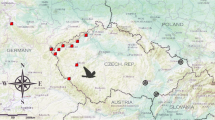Summary
The initial orientation of pigeons with various degrees of homing experience was investigated in releases over the sea. The collected data encompasses 22 releases in which a total of 160 pigeons were used and 415 vanishing points recorded. The experiments are grouped into three series:
-
1.
Five groups of young pigeons without homing experience were released over the sea NE, S, and WNW of the loft, situated at S. Piero a Grado near Pisa. Mean directions taken by the birds were between W and NNW (Pigs. 1, 2). In at least four cases the choice seems to be the result of a compromise between a strong directional tendency and a homeward tendency.
-
2.
Young pigeons housed in a loft situated on the coast of the Isle of Capraia and released over the sea at a short distance gave evidence of an orientation influenced by the sight of the island. The pigeons were later divided into two groups and released at 30 km S and 76 km N (Fig. 3); distributions of vanishing points were not significantly different from each other.
-
3.
Two groups of adult pigeons, housed in the loft of S. Piero a Grado and directionally trained on two opposite lines along the coast, were later released from four different points over the sea. All mean directions lead approximately inland and are very close to one another. They do not seem to be affected by the differences in home direction. No deviations between the two groups as predictable on the basis of their training were observed while such deviations are seen to occur in two releases from an overland point (Fig. 6). The orientation over the sea was not guided by direct sensory contact with the land, since birds whose clock had been shifted six hours forward took a course parallel to the coast (Fig. 9). It is tentatively assumed that the birds orientated towards the land by means of a sun-compass mechanism assuming a perpendicular direction to the stretch of the coast with which they had become familiar during their training flights.
Similar content being viewed by others
References
Baldaccini, N. E., Fiaschi, V., Fiore, L., Papi, F.: Initial orientation of directionally trained pigeons under overcast and sunny conditions. Monit. zool. ital. (N. S.) (in press) (1971).
Batschelet, E.: Statistical methods for the analysis of problems in animal orientation and certain biological rhythms. Washington, D. C.: American Institute of biological Sciences 1965.
Graue, L. C.: Experience effect on initial orientation on pigeon homing. Anim. Behav. 13, 149–153 (1965).
—: Orientation and distance in pigeon homing (Columba livia). Anim. Behav. 18, 36–40 (1970).
Keeton, W. T.: “Distance effect” in pigeon orientation: an evaluation. Biol. Bull. 139, 510–519 (1970).
Matthews, G. V. T.: The orientation of pigeons as affected by the learning of land-marks and by the distance of displacement. Anim. Behav. 11, 310–317 (1963).
—: Bird navigation. Cambridge: University Press 1968.
Papi, F.: Astronomische Orientierung bei der Wolfspinne Arctosa perita (Latr.). Z. vergl. Physiol. 37, 230–233 (1955).
—, Pardi, L.: Are pigeons able to home when released over the sea ? Monit. zool. ital. (N.S.) 2, 217–231 (1968).
Pardi, L., Papi, F.: Ricerche sull'orientamento di Talitrus saltator (Montagu) (Crustacea-Amphipoda). I. L'orientamento durante il giorno di una popolazione del litorale tirrenico. Z. vergl. Physiol. 35, 459–489 (1953).
Schmidt-Koenig, K.: Über die Entfernung als Parameter bei der Anfangsorientierung der Brieftaube. Z. vergl. Physiol. 52, 33–55 (1966).
—: Entfernung und Heimkehrverhalten der Brieftaube. Z. vergl. Physiol. 68, 39–48 (1970).
Siegel, S.: Nonparametric statistics: for the behavioral sciences. New York: McGraw-Hill Book Co. 1956.
Wagner, G.: Topographisch bedingte zweigipflige und schiefe Kreisverteilungen bei der Anfangsorientierung verfrachteter Brieftauben. Revue suisse Zool. 75, 682–690 (1968).
Wallraff, H. G.: Über den Einfluß der Erfahrung auf das Heimfindevermögen von Brieftauben. Z. Tierpsyohol. 16, 424–444 (1959a).
—: Örtlich und zeitlich bedingte Variabilität des Heimkehrverhaltens von Brieftauben. Z. Tierpsychol. 16, 513–544 (1959b).
—:Über die Flugrichtungen verfrachteter Brieftauben in Abhängigkeit vom Heimatort und vom Ort der Freilassung. Z. Tierpsychol. 27, 303–351 (1970).
Author information
Authors and Affiliations
Additional information
This work was supported by the Consiglio Nazionale delle Ricerche.
We express our gratitude to the officials and the organizations that kindly allowed us the use of the naval craft needed for the releases and especially to Commander S. Scotto di Santillo of the Consiglio Nazionale delle Ricerche, to the Ispettorato generale delle Capitanerie di Porto, to the Capitanerie di Porto di Savona, Civitavecchia and Gaeta, to prof. B. Battaglia, Director of the Istituto di Biologia del Mare of Venice, and to Prof. R. Nobili, Director of the Centro Interuniversitario di Biologia Marina of Leghorn.
A special note of thanks goes to Mr. S. Carnasciali for his constant care of the animals and for his valuable assistance in the organization of the releases and in recording the vanishing points of the birds.
Rights and permissions
About this article
Cite this article
Papi, F., Fiore, L., Fiaschi, V. et al. Orientation of homing pigeons released over the sea. Z. Vergl. Physiol. 73, 317–338 (1971). https://doi.org/10.1007/BF00297679
Received:
Issue Date:
DOI: https://doi.org/10.1007/BF00297679




